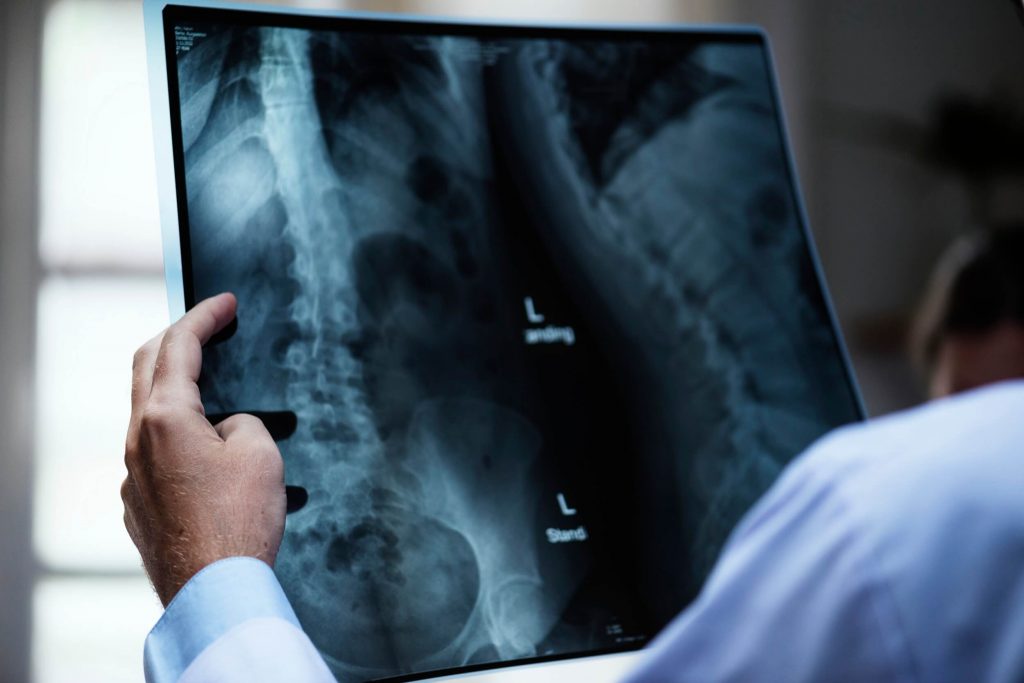Let’s discuss the difference between an annular tear vs herniated disc. Is there actually a difference between these two conditions? Considering that they’re both spinal disc issues, are they connected in some way? Are there differences in how they need to be treated?
Dr. Kevin Pauza believes that the first step to getting the help you need for back or neck pain is to truly understand the root cause of it. That’s why in this article, we’ll be answering all of these questions and more to ensure you’re fully informed about annular tears and herniated discs.
What are Annular Tears?
In order to begin discussing the difference between an annular tear vs herniated disc, we need to talk about the specifics of each condition.
The condition we know as an annular tear occurs when the outer layer of your spinal disc, the annulus fibrosus, becomes torn as a result of damage. When these tears occur, the jelly-like inner portion of your spinal disc, the nucleus pulposus, can leak out.
When the nucleus pulposus begins to leak out of the spinal disc, this reduces the cushion that your spinal discs provide for your vertebrae. When spinal discs are healthy, they enable the spine to be flexible and move freely without difficulty or pain. In addition to this, healthy spinal discs also absorb the shock caused by our daily activities. For example, sitting or standing for long periods of time can put a strain on your spine, and healthy spinal discs reduce this strain.
Unfortunately, as part of our natural aging process, these same forces that the spinal discs are meant to absorb also break them down over time. However, there are many other potential causes of annular tears as well, which we’ll discuss below.

Causes
Annular tears can be caused by gradual wear and tear that happens as a result of aging or following a sudden, traumatic injury. The following are other common causes of annular tears.
- Traumatic injury. Injuries such as those caused by sports accidents, car collisions, or a fall can cause immediate damage to a spinal disc that results in tearing.
- Overuse. Repetitively lifting heavy objects or working in an occupation that places consistent stress on your spine can result in annular tears.
- Genetics. Your family history and genes can actually determine the strength and quality of your body’s collagen, which is the material that makes up the annulus fibrosus. If your collagen is not very strong, you’ll be more prone to developing annular tears.
Symptoms
Pain caused by annular tears is usually related to the location of the affected spinal disc. For example, if the torn spinal disc is located in your neck (cervical spine), you’ll have pain around that area. If the damaged disc is located in your lower back (lumbar spine), that’s where your symptoms will be felt.
- Annular tears in the cervical spine: symptoms caused by annular tears located in your neck can cause pain to radiate into your arms and hands. You may also experience muscle weakness, tingling, or numbness in these areas.
- Annular tears in the lumbar spine: if your torn spinal disc is located in your lower back, pain may radiate to your legs or feet. You may also feel symptoms of sciatica if the leaking of the nucleus pulposus affects the sciatica nerve. In addition to this, you may experience muscle weakness, tingling, or numbness in the legs and feet.
A more general symptom of annular tears regardless of their location is back pain that worsens when you sit, bend, lift, or twist. When suffering from annular tear pain, you may also feel some relief when you switch positions, lie down, walk, or run. Learn more about annular tear symptoms here.
Leaky Disc Syndrome™
In addition to these symptoms, annular tears can cause significant issues as a result of Leaky Disc Syndrome™, a term that was coined by Dr. Kevin Pauza. Leaky Disc Syndrome™ occurs when annular tears the annulus fibrosus is no longer able to contain the nucleus pulposus. This allows the nucleus pulposus to leak out and come into contact with sensory nerves contained in the annulus fibrosus. The nucleus pulposus may also reach surrounding spinal nerve roots. Whether it comes into contact with sensory nerves or nerve roots, the nucleus pulposus will irritate and inflame these nerves. Because the leaking affects nerve roots, a leaking nucleus pulposus can cause pain felt in the arms, hands, legs, and feet as well.
Leaky Disc Syndrome™ also causes spinal discs to break down due to dehydration (disc desiccation), which lowers the ability of the spinal discs to continue providing flexibility for the spine.

What is a Herniated Disc?
Now we’ll discuss the second part of the difference between an annular tear vs herniated disc. Similar to annular tears, a herniated disc is a condition that occurs when part of the spinal disc is pushed outside of the annulus fibrosus through a tear. Many refer to herniated discs as “bulging discs” or “ruptured discs” but these terms are inaccurate and are not the same as a herniated disc. This condition can be connected to degenerative disc disease, as disc herniation is usually an early stage of degeneration.
This condition can occur in any part of the spine, such as the cervical spine, thoracic spine, or lumbar spine. However, herniated discs most commonly occur in the lumbar spine because this area takes on the most stress. The area where your herniated disc is located will affect where you feel symptoms.
Unlike what most people believe, pain caused by a herniated disc is not usually caused by mechanical pressure resulting from the herniation, or a “pinched nerve”. Herniated disc pain is most commonly a result of the leaking of the nucleus pulposus, which we’ll discuss in further detail below.
Causes
Like annular tears, disc herniation often results from gradual, age-related wear and tear related to disc degeneration. There are other causes as well, which is why people usually can’t pinpoint the cause of a herniated disc. The following are common causes of herniated discs besides aging.
- Lifting. Using your back muscles rather than your leg and thigh muscles to lift heavy objects can cause disc herniation. In addition to this, twisting or turning while lifting a heavy object can lead to disc herniation as well.
- Traumatic injury. Injuries caused by sports accidents, car collisions, or a fall can cause damage to a spinal disc that results in herniation.
- Weight. Being overweight places increased stress on the lumbar spinal discs, putting you at greater risk of developing a herniated disc.
- Occupation. Physically demanding jobs have an increased risk of back issues due to repetitive lifting, pulling, pushing, bending forward, and twisting.
- Genetics. Your family history and genes can actually determine the strength and quality of your body’s collagen, which is the material that makes up the annulus fibrosus. If your collagen is not very strong, your likelihood of developing a herniated disc will be greater.
- Smoking. Smoking reduces the amount of oxygen supplied to the spinal discs, leading to dehydration and degeneration.
Symptoms
Symptoms of a herniated disc can vary greatly as they depend on the location of the affected disc and the severity of the herniation. In some cases, a person with a herniated disc will not experience any pain at all.
Typically, herniated disc pain is preceded by episodes of lower back pain or a long history of intermittent episodes of lower back pain. Herniated disc pain also causes back pain, numbness in the extremities, or muscle weakness, regardless of the location of the damaged disc.
Specifically, if your herniated disc is located in your lower back (lumbar spine), you may experience sciatica or radiculopathy symptoms caused by the herniated disc affecting the sciatic nerve. These sciatica symptoms can include pain, burning, tingling, and numbness that radiates from the buttock to the leg and sometimes even into the foot. In this situation, only one side of the body will typically be affected and the pain is commonly described as sharp and electric shock-like. Your pain may also worsen when you’re standing, walking, or sitting. In fact, you may even feel your pain worsen when you straighten your affected leg. In addition to leg pain, you’ll most likely experience lower back pain, but when dealing with sciatica the pain felt in the leg is usually worse than the pain felt in the lower back.
If the herniated disc is located in your neck (cervical spine), you may experience cervical radiculopathy in that area. This can include dull or sharp pain felt in your neck or between your shoulder blades, with pain radiating down your arm to the hand or fingers. You may also feel numbness or tingling in your shoulder or arm. Your pain may increase when your neck is in a certain position or moved a certain way.
How Annular Tears, Leaky Disc Syndrome™, and Herniated Discs are Connected
When discussing the difference between an annular tear vs herniated disc, it’s important to note that these two conditions are actually connected. Herniated discs occur as a result of annular tears and the pain associated with herniated discs is actually caused by leaking as a result of annular tears.
Many people, and even physicians, believe that the physical compression of a nerve is what causes herniated disc pain. While this is true in some cases, more often than not, people experience herniated disc pain due to the leaking of the nucleus pulposus through the annulus fibrosus.
As you know, disc herniation occurs because part of the spinal disc is pushed outside of the annulus fibrosus through an annular tear. You also know that annular tears can cause Leaky Disc Syndrome™, which causes irritation, inflammation, and pain that can be felt in the arms, hands, legs, and feet. So while these two conditions are different, herniated discs cannot occur without annular tears and herniated disc pain is usually not felt without leaking caused by annular tears.
How Dr. Pauza’s Discseel® Procedure Is Used to Treat an Annular Tear vs Herniated Disc
The most common ways to treat herniated disc pain include conservative methods, such as medication or physical therapy. If these treatments don’t work, surgery is usually recommended as the only remaining option. However, a third option is available that is proven to effectively treat herniated disc pain without surgery.
The Discseel Procedure, invented by Dr. Pauza, is a non-surgical, minimally invasive spine procedure that uses an orthobiologic to address annular tears and relieve back and neck pain. This is the only procedure that was designed to address annular tears and stop the leaking of the nucleus pulposus.
Whether your pain is caused by herniated discs, degenerative disc disease, sciatica, or chronic lower back pain, the Discseel Procedure may be able to help you. Apply for the Discseel Procedure today and find out if you’re a candidate for this innovative procedure!
Featured image by wayhomestudio – www.freepik.com

